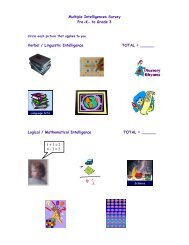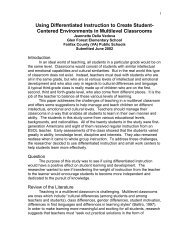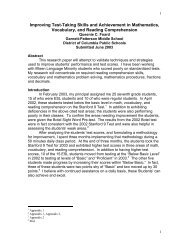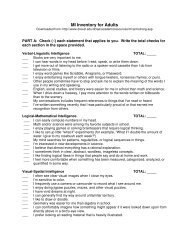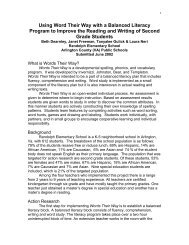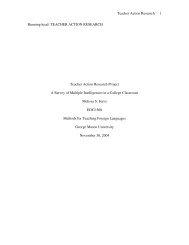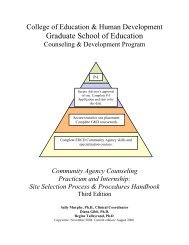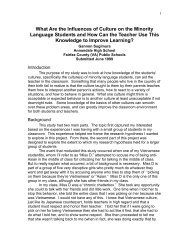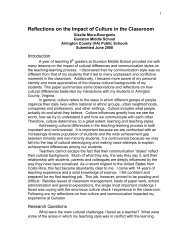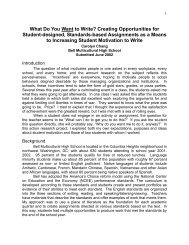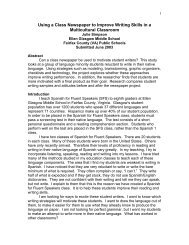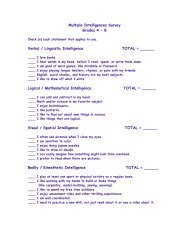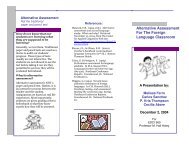Using Sentence Frames to Enhance Writing in a K-1 Classroom
Using Sentence Frames to Enhance Writing in a K-1 Classroom
Using Sentence Frames to Enhance Writing in a K-1 Classroom
Create successful ePaper yourself
Turn your PDF publications into a flip-book with our unique Google optimized e-Paper software.
Elementary is a school<br />
full of opportunities for students. It is located <strong>in</strong><br />
Northern Virg<strong>in</strong>ia <strong>in</strong> a neighborhood. The school is<br />
a center school for the Advanced Academics<br />
Program (AAP),therefore the student body is<br />
made up of local students as well as students<br />
who are <strong>in</strong> the AAP program. The school is<br />
a Kennedy Center Chang<strong>in</strong>g Education Through<br />
the Arts (CETA) school. This makes the school<br />
unique because the arts are <strong>in</strong>tegrated<br />
<strong>in</strong><strong>to</strong> the core curriculum at the school.<br />
The Core Class<br />
The classroom <strong>in</strong> which the research<br />
<strong>to</strong>ok place is a K<strong>in</strong>dergarten- First Grade<br />
multiage classroom. There are 13 First Graders<br />
and 9 K<strong>in</strong>dergarteners for a <strong>to</strong>tal of 22 students.<br />
There are 6 students who qualify for ESOL<br />
services and 3 students who are pulled for<br />
Advanced Academic Placement enrichment. Mrs. T<br />
practices Responsive <strong>Classroom</strong> <strong>in</strong> her<br />
room <strong>to</strong> help students become <strong>in</strong>dependent <strong>in</strong><br />
their decisions and take responsibility for their<br />
actions. The classroom is rich with text <strong>to</strong><br />
<strong>in</strong>fluence student writ<strong>in</strong>g and students have a<br />
variety of opportunities and avenues <strong>to</strong> express<br />
themselves through writ<strong>in</strong>g.<br />
The Process<br />
Hav<strong>in</strong>g a multiage classroom presents the<br />
challenge of scaffold<strong>in</strong>g enough for both ages while<br />
extend<strong>in</strong>g for the First Graders <strong>to</strong> prepare them <strong>to</strong><br />
enter Second Grade. I noticed that many of the<br />
students were struggl<strong>in</strong>g <strong>to</strong> f<strong>in</strong>d the words <strong>to</strong> start<br />
sentences and would end up writ<strong>in</strong>g down answers<br />
without actually start<strong>in</strong>g a sentence <strong>to</strong> let the<br />
reader know what they were writ<strong>in</strong>g about. I<br />
wondered if us<strong>in</strong>g a sentence frame would help<br />
students <strong>to</strong> better form their ideas and limit the<br />
number of responses that seemed <strong>to</strong> be written<br />
without a clear purpose stated <strong>to</strong> the reader.<br />
The Research<br />
<strong>Sentence</strong> frames or paragraph frames help<br />
students <strong>to</strong> organize <strong>in</strong>formation and better<br />
understand the relationship between their writ<strong>in</strong>g<br />
and the <strong>in</strong>formation presented. Implementation is<br />
achieved by first read<strong>in</strong>g the text <strong>to</strong> the students<br />
and then show<strong>in</strong>g them the frame <strong>to</strong> write from<br />
(Wiesendanger).<br />
<strong>Sentence</strong> frames and paragraph frames are<br />
most effective when students are provided with the<br />
frame or have the frame <strong>to</strong> copy <strong>to</strong> beg<strong>in</strong> their<br />
sentences and then fill <strong>in</strong> their responses <strong>to</strong> the<br />
prompts (Cudd & Roberts).<br />
The Question:<br />
How will <strong>in</strong>troduc<strong>in</strong>g a<br />
sentence frame <strong>in</strong> language<br />
arts help students <strong>to</strong> write<br />
about the problem and<br />
solution <strong>in</strong> a s<strong>to</strong>ry<br />
Data Collection<br />
I decided <strong>to</strong> collect data through multiple<br />
avenues. The ma<strong>in</strong> data collection was through<br />
samples of student writ<strong>in</strong>g analysis. To scaffold the<br />
writ<strong>in</strong>g for different ability levels all writ<strong>in</strong>g papers<br />
had space <strong>to</strong> draw a picture as well as write words.<br />
The second type of data collection was tally<strong>in</strong>g how<br />
many students decided <strong>to</strong> use the sentence frame<br />
when given the option. The third type of data<br />
collection was student <strong>in</strong>terviews <strong>to</strong> assess if<br />
students were f<strong>in</strong>d<strong>in</strong>g the sentence frame <strong>to</strong> be<br />
useful. To conduct the <strong>in</strong>terviews, I asked students<br />
if the sentence frames helped them <strong>to</strong> write and if<br />
they liked us<strong>in</strong>g it. I also provided a sample of a<br />
worksheet we had used so they could see what I was<br />
talk<strong>in</strong>g about.<br />
Implementation<br />
The students had already reviewed and<br />
talked about f<strong>in</strong>d<strong>in</strong>g the problem and solution <strong>in</strong> a<br />
s<strong>to</strong>ry, therefore my implementation was more<br />
focused on us<strong>in</strong>g the sentence frame rather than<br />
teach<strong>in</strong>g the new material.<br />
I began implement<strong>in</strong>g the sentence frame<br />
by read<strong>in</strong>g aloud Jamie O’Rourke and the Big Pota<strong>to</strong><br />
and discuss<strong>in</strong>g the problem and solution <strong>in</strong> the s<strong>to</strong>ry<br />
with the students. As a class, we phrased our<br />
responses <strong>to</strong> be <strong>in</strong> the sentence frame format. Then,<br />
I gave students a paper <strong>to</strong> write their response with<br />
an area <strong>to</strong> draw their picture. Most students did not<br />
write <strong>in</strong> complete sentences and a few wrote about<br />
someth<strong>in</strong>g other than the problem and solution.<br />
Dur<strong>in</strong>g the second implementation, I read a<br />
big book aloud, Gu<strong>in</strong>ea Pig Grass, and aga<strong>in</strong> asked<br />
students <strong>to</strong> formulate their response for the<br />
problem and solution of the s<strong>to</strong>ry. Then, students<br />
wrote their responses on paper which had already<br />
been prepared with the sentence frame. The<br />
student responses were much more clear and<br />
concise.<br />
Over the next week, students cont<strong>in</strong>ued <strong>to</strong><br />
write about the problem and solution <strong>to</strong> text at the<br />
listen<strong>in</strong>g center and at the big book station.<br />
For the f<strong>in</strong>al implementation, I read The<br />
Best Loved Bear and we discussed the problem and<br />
solution as a group. Then students were given a<br />
choice of writ<strong>in</strong>g on paper prepared with the<br />
sentence frame or without it.<br />
The <strong>Sentence</strong> Frame:<br />
The problem <strong>in</strong> ________<br />
is ____________. The<br />
solution <strong>to</strong> the problem is<br />
_________.



